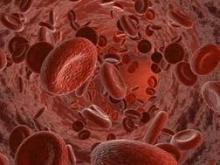The novel oral anticoagulants dabigatran and rivaroxaban have had only “modest” uptake into real-world clinical practice as thromboembolism prevention in high-risk patients with atrial fibrillation, according to a report published online June 9 in Circulation: Cardiovascular Outcomes and Quality.
These drugs have proved to be at least as effective as warfarin at prophylaxis in this patient population, appear to be safer than warfarin regarding the risk of intracranial hemorrhage, and are more practical because they don’t require routine monitoring and have more predictable treatment effects. Yet little is known about their adoption into real-world practice, said Dr. Priyesh A. Patel of Duke Clinical Research Institute in Durham, N.C., and his associates.
The investigators examined the issue by analyzing hospital records in the database of the Get With The Guidelines–Stroke initiative, a project aimed at improving overall stroke care. They focused on 61,655 patients with AF who were hospitalized for ischemic stroke or transient ischemic attack (TIA) and discharged on dabigatran, rivaroxaban, or warfarin during a 2-year period after FDA approval of the new agents. Dabigatran was prescribed to 9.6% of these patients, rivaroxaban to 1.5%, and warfarin to 88.9%.
“Our study shows modest early adoption rates for novel oral anticoagulant therapy” of 16%-17%. Yet this rate falls in the upper range of estimated uptakes in studies that describe early utilization patterns of drugs – including the initially modest adoption of warfarin for this indication, Dr. Patel and his associates said (Circ. Cardiovasc. Qual. Outcomes 2015 June 9 [doi:10.1161/circoutcomes.114.000907]).
The relative expense of the newer agents likely played a role in hindering diffusion into clinical practice because patients who lacked health insurance or were covered by Medicare/Medicaid were more likely to receive warfarin. In addition, clinicians may hesitate to prescribe dabigatran or rivaroxaban because real-world patients differ markedly from those included in clinical trials of these drugs. In this study, for example, participants were older, more likely to be female, less likely to be ambulatory, and had higher scores on measures of risk such as CHADS2 and CHA2DS2-VASc scores, compared with clinical study subjects, they said.
This study also uncovered one particularly worrying fact: 1.4% of patients discharged on dabigatran or rivaroxaban had prosthetic heart valves and 31% had known coronary artery disease, which can be contraindications to using these agents. “Further education on the risks and benefits of novel oral anticoagulation therapy may be needed to increase familiarity with these drugs and prevent risk-treatment mismatches or adverse events,” Dr. Patel and his associates added.
This study was funded by grants from the American Heart Association and the National Institutes of Health. Dr. Patel reported having no financial disclosures; his associates reported ties to numerous industry sources.


